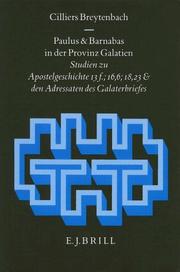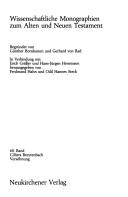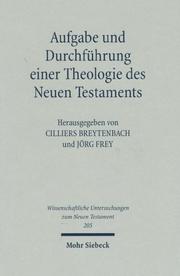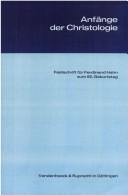| Listing 1 - 10 of 30 | << page >> |
Sort by
|
Book
ISBN: 9789042932715 9042932716 Year: 2015 Volume: 277 Publisher: Leuven Peeters
Abstract | Keywords | Export | Availability | Bookmark
 Loading...
Loading...Choose an application
- Reference Manager
- EndNote
- RefWorks (Direct export to RefWorks)
These papers of the 62th Colloquium Biblicum Lovaniense (July 16-18, 2013) illustrate that the Apostle Paul is an excellent example for the cultural exchange so typical of the eastern provinces of the Roman Empire during the early imperial age. He was a Jew from Tarsus and regarded himself, according to his own words, as Hebrew descended from Hebrews, and as Pharisee according to the way of interpreting the Law. However, he wrote his letters in Greek, showing acquaintance not only with the Greek translations of the Law and the Prophets, but also with contemporary Greek philosophical concepts, rhetorical style and e.g. the tradition of Euripides' tragedies. He lived and worked in several Roman colonies and absorbed Romanized concepts, metaphors and a vision of reaching from the eastern frontier of the Empire to Spain in the West. Influenced by different intellectual worlds, Paul stood at the crossroads of cultural interaction.
Paul [Apostle] --- Paul, --- Bible. --- Criticism, interpretation, etc. --- Academic collection --- 227.08 --- 227.1 --- Paulinische theologie --- Brieven van Paulus--(algemeen) --- Conferences - Meetings --- 227.1 Brieven van Paulus--(algemeen) --- 227.08 Paulinische theologie --- Paul --- Congresses --- Bible. N.T. Epistles of Paul --- Criticism, interpretation, etc --- Church history --- Primitive and early church, ca. 30-600 A.D.
Book
ISBN: 3290120716 9783290120719 Year: 1984 Volume: 71 Publisher: Zürich Teologischer verlag
Abstract | Keywords | Export | Availability | Bookmark
 Loading...
Loading...Choose an application
- Reference Manager
- EndNote
- RefWorks (Direct export to RefWorks)
Christian life --- Eschatology --- Biblical teaching --- Bible --- Criticism, interpretation, etc --- 226.3 --- -Eschatology --- -Last things (Theology) --- Religious thought --- Theology, Doctrinal --- Christians --- Discipleship --- Religious life --- Theology, Practical --- Evangelie volgens Marcus --- Christianity --- -Evangelie volgens Marcus --- Bible. --- Marco (Book of the New Testament) --- Mark (Book of the New Testament) --- Markus (Book of the New Testament) --- Markusevangelium --- Vangelo di Marco --- Criticism, interpretation, etc. --- Marc (Saint). Evangile. Théologie. --- Marcus (Hl.). Evangelie. Godgeleerdheid. --- Book of Mark --- Christian life - Biblical teaching --- Eschatology - Biblical teaching

ISBN: 9004106936 9004332480 9789004106932 9789004332485 Year: 1996 Volume: 38 Publisher: Leiden ; New York : E.J. Brill,
Abstract | Keywords | Export | Availability | Bookmark
 Loading...
Loading...Choose an application
- Reference Manager
- EndNote
- RefWorks (Direct export to RefWorks)
This study poses and answers two questions: 1. What is the basis in the tradition for the Acts 13 and 14 narrative about Paul's and Barnabas' mission on Cyprus and in southern Galatia? 2. Who are the addressees of the letter to the Galatians? Using the extant inscriptions and literary sources that relate to the provinces of Cyprus and Galatia in the early Roman Empire, the above questions are addressed to Acts and Galatians, and answered as follows: 1 Acts 13-14 contains so much local colour as to rule out the thesis that the so-called first missionary journey is fictional. 2. Paul's letter to the Galatians is addressed to the churches in southern Galatia - Antioch, Iconium, Lystra and Derbe. The hypothesis of a north-Galatian setting is shown to be improbable in the light of the geographical, archaeological and epigraphic evidence.
Paul --- Barnabas --- 226.6 --- 227.1*3 --- Handelingen der apostelen. Akten van de apostelen --- Brief van Paulus aan de Galaten --- Barnabas Apostle, Saint --- Paul the Apostle, Saint --- 227.1*3 Brief van Paulus aan de Galaten --- Barnabas, --- Paul, --- Pavel, --- Pavol, --- Paulus von Tarsus, --- Paulos, --- Pōghos, --- Paweł, --- Paweł z Tarsu, --- Būlus, --- Pablo, --- Paulo de Tarso, --- Paolo di Tarso, --- Pál, --- Apostolos Paulos --- Saul, --- القديس بولس الرسول --- بولس، --- 사도바울 --- Bible. --- Brief aan die Galasiërs --- Epistle to the Galatians (Book of the New Testament) --- Galasiërs --- Galatians (Book of the New Testament) --- Galladia --- Galladia-sŏ --- Galladiasŏ --- Garateya sho --- Kalladiasŏ --- Criticism, interpretation, etc. --- Paulus, --- Pawełm --- Paulo, --- Paolo, --- Levite, --- Joseph, --- Joses, --- Varnavas, --- Joseph Barnabas, --- Βαρναβα
Book
ISBN: 128311965X 9786613119650 9004188045 9789004188044 9789004186088 9004186085 6613119652 Year: 2010 Volume: 135 Publisher: Leiden Boston Brill
Abstract | Keywords | Export | Availability | Bookmark
 Loading...
Loading...Choose an application
- Reference Manager
- EndNote
- RefWorks (Direct export to RefWorks)
How did the first Christians interpret the death of Christ? The answer lies within the earliest Christian documents, primarily within the Pauline letters. Before the users of a modern language could hope to come near an adequate description of what was expressed in these Greek texts of the first Christians, they have to deconstruct layers of later dogmatic interpretation. They need to keep to descriptive terminology reflecting the Greek of the sources and to trace the origin of the metaphoric language early Christians like Paul used. This volume sets out to construct some of the Jewish and Greco-Roman patterns of thought which were initially utilised to express the meaning of the death of Christ.
Bible. N.T. Epistles of Paul -- Theology. --- Civilization, Greco-Roman. --- Jesus Christ - Crucifixion. --- Jesus Christ -- Crucifixion. --- Metaphor - Religious aspects - Christianity. --- Metaphor -- Religious aspects -- Christianity. --- Metaphor --- Civilization, Greco-Roman --- Religion --- Philosophy & Religion --- Christianity --- Religious aspects --- Christianity. --- Jesus Christ --- Crucifixion. --- Bible. --- Theology. --- Greco-Roman civilization --- Christ --- Cristo --- Jezus Chrystus --- Jesus Cristo --- Jesus, --- Jezus --- Christ, Jesus --- Yeh-su --- Masīḥ --- Khristos --- Gesù --- Christo --- Yeshua --- Chrystus --- Gesú Cristo --- Ježíš --- Isa, --- Nabi Isa --- Isa Al-Masih --- Al-Masih, Isa --- Masih, Isa Al --- -Jesus, --- Jesucristo --- Yesu --- Yeh-su Chi-tu --- Iēsous --- Iēsous Christos --- Iēsous, --- Kʻristos --- Hisus Kʻristos --- Christos --- Jesuo --- Yeshuʻa ben Yosef --- Yeshua ben Yoseph --- Iisus --- Iisus Khristos --- Jeschua ben Joseph --- Ieso Kriʻste --- Yesus --- Kristus --- ישו --- ישו הנוצרי --- ישו הנצרי --- ישוע --- ישוע בן יוסף --- المسيح --- مسيح --- يسوع المسيح --- 耶稣 --- 耶稣基督 --- 예수그리스도 --- Jíizis --- Yéshoua --- Iėsu̇s --- Khrist Iėsu̇s --- عيسىٰ --- Epistles of Paul --- Paul, Epistles of --- Paul Sŏsin --- Pauline epistles --- Risālat al-Qiddīs Būlus al-rasūl al-thāniyah ilá Tīmūthīʼūs --- Civilization, Classical --- عيسىٰ --- 225*6 --- Parabole --- Figures of speech --- Reification --- 225*6 Graflegging van Jezus. Lege graf. Verrijzenis en verheerlijking van Jezus --- Graflegging van Jezus. Lege graf. Verrijzenis en verheerlijking van Jezus --- Religious aspects&delete& --- Métaphore --- Civilisation gréco-romaine --- Aspect religieux --- Christianisme

ISBN: 3788712694 9783788712693 Year: 1989 Volume: 60 Publisher: Neukirchen-Vluyn Neukirchener Verl.
Abstract | Keywords | Export | Availability | Bookmark
 Loading...
Loading...Choose an application
- Reference Manager
- EndNote
- RefWorks (Direct export to RefWorks)
Reconciliation --- Biblical teaching. --- 227.08 --- #GROL:SEMI-22<08> Wiss 60 --- 234 --- Paulinische theologie --- Soteriologie. Heilsleer. Genade. Geloof --- 227.08 Paulinische theologie --- Biblical teaching --- Bible. --- Epistles of Paul --- Paul, Epistles of --- Paul Sŏsin --- Pauline epistles --- Risālat al-Qiddīs Būlus al-rasūl al-thāniyah ilá Tīmūthīʼūs --- Criticism, interpretation, etc. --- Reconciliation - Biblical teaching.
Book
ISSN: 01679732 ISBN: 9789004443334 9004443339 9789004443754 9004443754 Year: 2021 Volume: 182 Publisher: Leiden, the Netherlands ; Boston, Massachusetts : BRILL,
Abstract | Keywords | Export | Availability | Bookmark
 Loading...
Loading...Choose an application
- Reference Manager
- EndNote
- RefWorks (Direct export to RefWorks)
"In this collection of thematically arranged essays on the Gospel according to Mark, the first part highlights its reception in early Christianity, its text form as an episodic narrative and its relation to contemporary genres. It recognizes Mark's dependence on traditions from and about Jesus of Nazareth and the presupposed knowledge about the narrated locations in Galilee. The second part focuses on the discourse itself, presenting studies on style, use of metaphor, intertextuality, and strategies of persuasion. The third part treats the Christology, ethics and eschatology and the way in which the narrator gives meaning to Jesus's death. The fourth part returns to the burning issue of what lies behind Mark and how we can study it, ending with a proposal to discuss the composition of the narrative within the framework of performance theory"--
Bible. --- Criticism, interpretation, etc. --- 226.3 --- 226.3 Evangelie volgens Marcus --- 226.3 Evangile de S. Marc --- Evangelie volgens Marcus --- Evangile de S. Marc --- Marco (Book of the New Testament) --- Mark (Book of the New Testament) --- Markus (Book of the New Testament) --- Markusevangelium --- Vangelo di Marco --- Book of Mark --- Theology --- History --- Christian life. --- Christian life --- Christians --- Discipleship --- Religious life --- Theology, Practical --- Christianity
Book
ISBN: 9783161595615 3161595610 9783161598265 Year: 2020 Volume: 448 Publisher: Tübingen Mohr Siebeck
Abstract | Keywords | Export | Availability | Bookmark
 Loading...
Loading...Choose an application
- Reference Manager
- EndNote
- RefWorks (Direct export to RefWorks)
"Cilliers Breytenbach presents his view of New Testament exegesis as historical discourse studies and the subdisciplines based on them, and shows various usages of exegesis. He highlights aspects in works written by experts in the field and traces the history of the subject in Berlin." --provided by publisher "Cilliers Breytenbach stellt seine Sicht der Exegese des Neuen Testaments als historische Textwissenschaft und der darauf aufbauenden Teildisziplinen dar und zeigt verschiedene Gebrauchsweisen von Exegese auf. Er richtet Schlaglichter auf Aspekte des Werks wichtiger Fachvertreter und zeichnet die Geschichte des Faches in Berlin nach." --
225.06 --- 225.06 Nieuw Testament: exegese; hermeneutiek--(theorie en methoden) --- Nieuw Testament: exegese; hermeneutiek--(theorie en methoden) --- Bible. --- Ba-yon Tipan --- Bagong Tipan --- Jaji ma Hungi --- Kainē Diathēkē --- New Testament --- Nouveau Testament --- Novo Testamento --- Novum Testamentum --- Novyĭ Zavet --- Novyĭ Zavi︠e︡t Gospoda nashego Īisusa Khrista --- Novyĭ Zavit --- Nuevo Testamento --- Nuovo Testamento --- Nye Testamente --- Perjanjian Baru --- Dhamma sacʻ kyamʻʺ --- Injīl --- Criticism, interpretation, etc.
Book
ISBN: 9783161478581 Year: 2007 Publisher: Mohr Siebeck
Abstract | Keywords | Export | Availability | Bookmark
 Loading...
Loading...Choose an application
- Reference Manager
- EndNote
- RefWorks (Direct export to RefWorks)

ISBN: 9783161492525 3161492528 Year: 2007 Volume: 205 Publisher: Tübingen : Mohr Siebeck,
Abstract | Keywords | Export | Availability | Bookmark
 Loading...
Loading...Choose an application
- Reference Manager
- EndNote
- RefWorks (Direct export to RefWorks)
Bible --- Theology --- 225.08 --- Nieuw Testament: bijbelse theologie--(algemeen) --- 225.08 Nieuw Testament: bijbelse theologie--(algemeen) --- Bible. --- Ba-yon Tipan --- Bagong Tipan --- Jaji ma Hungi --- Kainē Diathēkē --- New Testament --- Nouveau Testament --- Novo Testamento --- Novum Testamentum --- Novyĭ Zavet --- Novyĭ Zavi︠e︡t Gospoda nashego Īisusa Khrista --- Novyĭ Zavit --- Nuevo Testamento --- Nuovo Testamento --- Nye Testamente --- Perjanjian Baru --- Dhamma sacʻ kyamʻʺ --- Injīl

ISBN: 3525581572 9783525581575 Year: 1991 Publisher: Göttingen Vandenhoeck und Ruprecht
Abstract | Keywords | Export | Availability | Bookmark
 Loading...
Loading...Choose an application
- Reference Manager
- EndNote
- RefWorks (Direct export to RefWorks)
| Listing 1 - 10 of 30 | << page >> |
Sort by
|

 Search
Search Feedback
Feedback About UniCat
About UniCat  Help
Help News
News